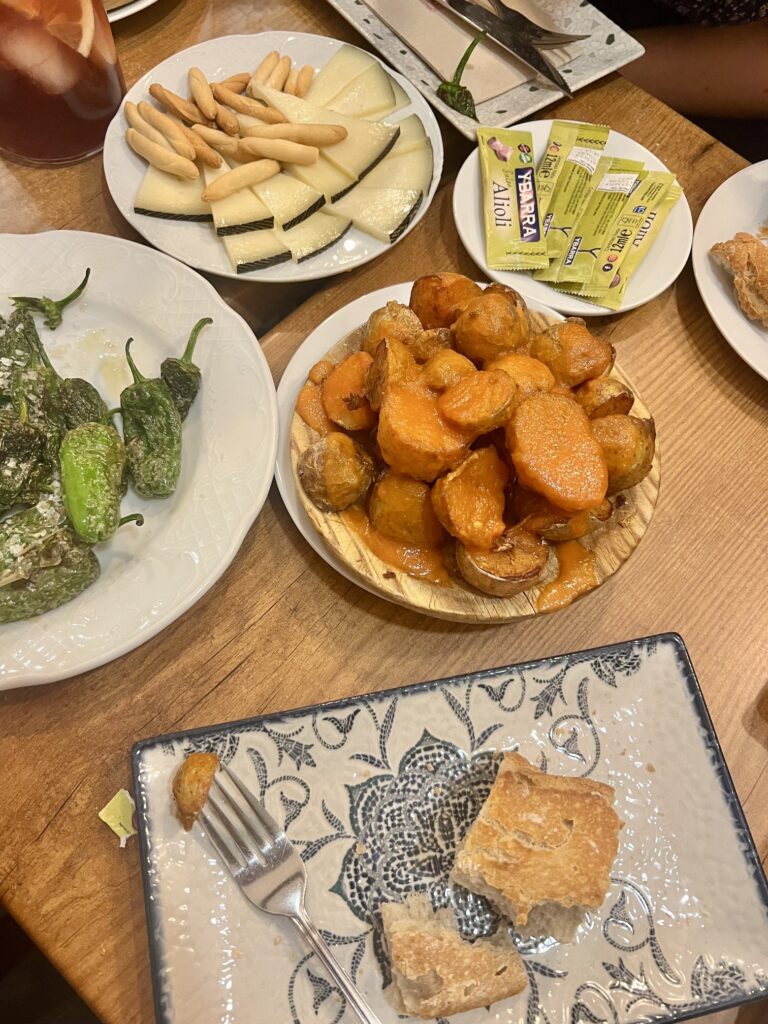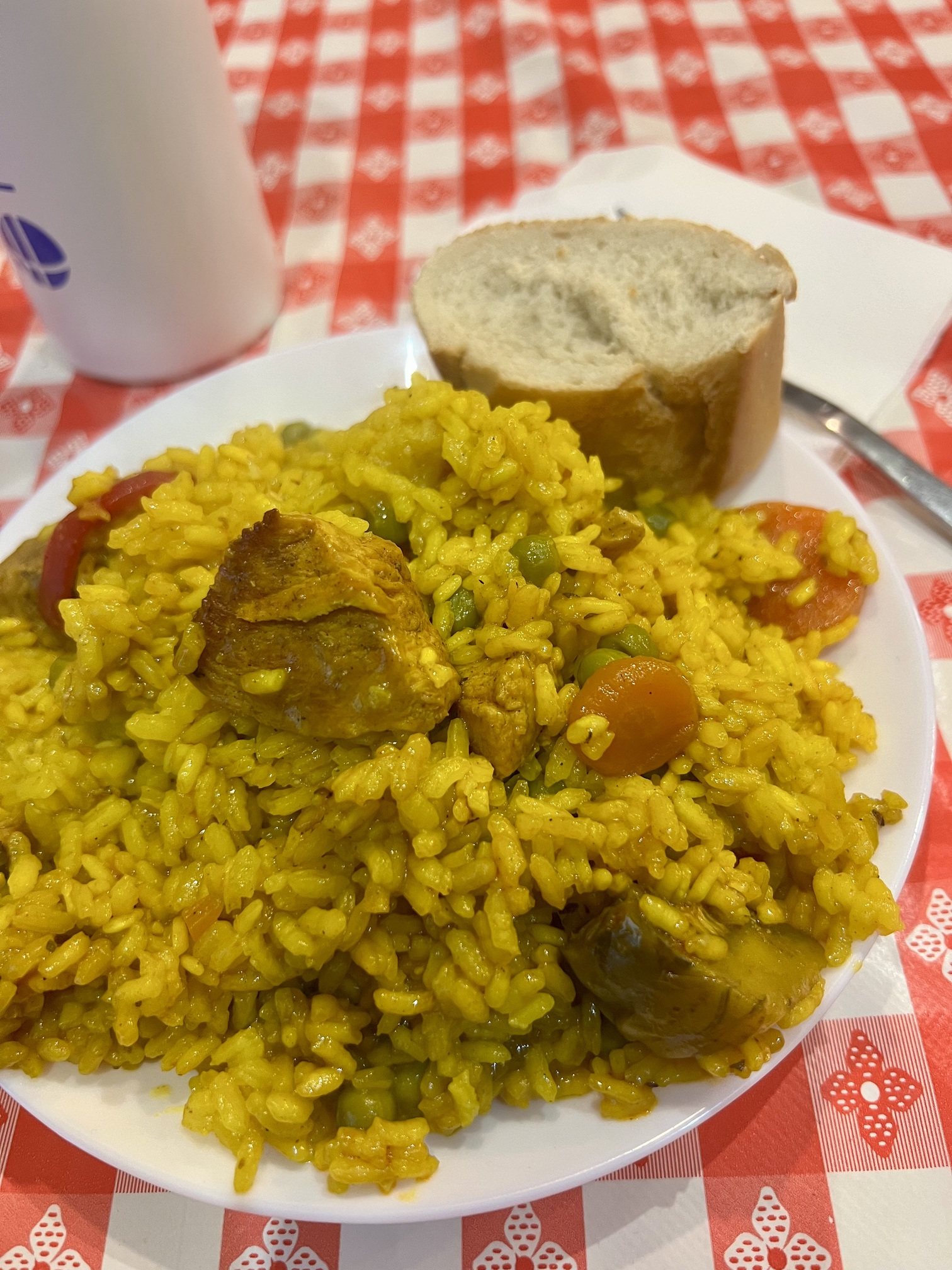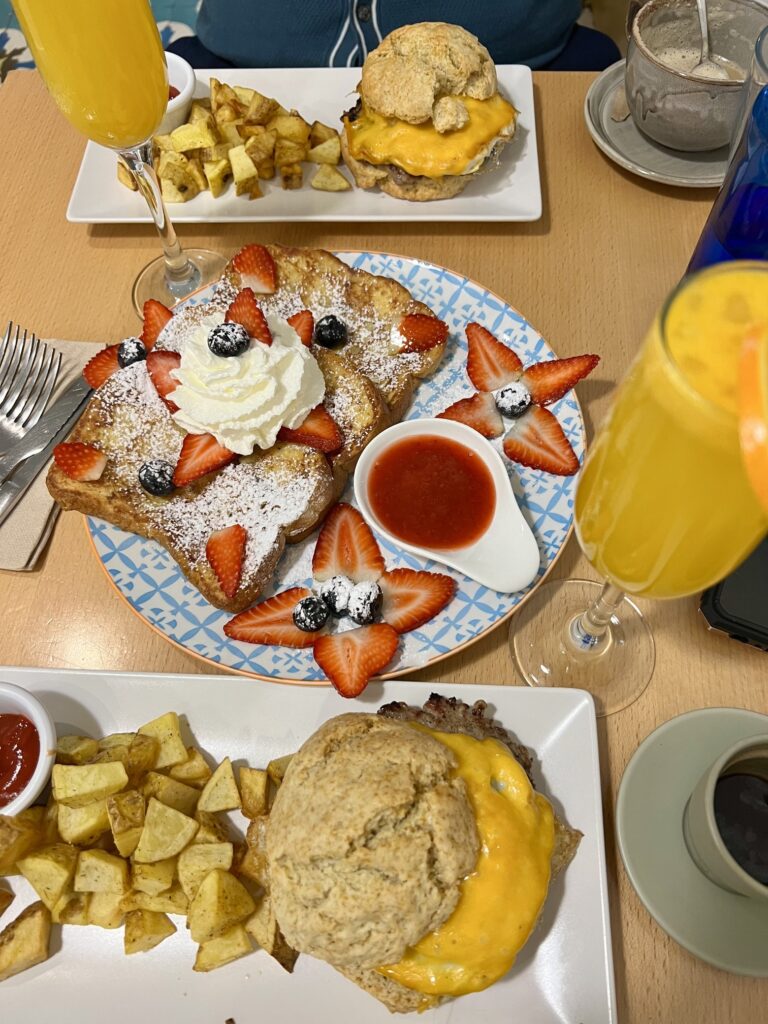
Authentic Spanish Food to Try in Spain: Culinary Delights
 October 24
October 24
 13 min read
13 min read

Authentic Spanish Food to Try in Spain: Culinary Delights-Key Highlights
- From tapas bars to bustling food markets, Spain offers a culinary adventure like no other.
- Indulge in iconic dishes like paella, tortilla española, and the world-renowned jamón ibérico.
- Discover the diverse flavors of Spain’s regional cuisines, each with its own unique specialties.
- Learn about the history, cultural influences, and seasonal variations that shape Spanish gastronomy.
- Immerse yourself in the Spanish food scene by visiting local markets, attending food festivals, or taking a cooking class.
Introduction
Get ready to enjoy the amazing flavors of Spain! Spanish cuisine is full of fresh ingredients, strong flavors, and old traditions. You can find this good food in the busy tapas bars of Madrid or the lovely seaside restaurants of Valencia. Spain offers a tasty journey with experiences you will remember. Discover some of the most real and tasty Spanish dishes that will make you want more.
Discover Authentic Spanish Dishes to Try in Spain
Spain is well-known for paella and sangria, but there is so much more to enjoy. To really taste Spanish cuisine, you should go beyond the popular dishes. Discover the hidden gems in different regions.
Get ready to enjoy tasty tapas. You can also savor delicious paellas and try unique regional dishes. Let’s start our culinary journey and find the best authentic Spanish dishes that will leave you wanting more!
1. Tortilla Española – The Quintessential Spanish Omelette
No trip to Spain is complete without trying Tortilla Española, or tortilla de patatas. This famous dish is very important in Spanish cuisine.
It’s made with just a few simple ingredients: potatoes, eggs, and olive oil. The tortilla española shows how Spanish food makes great flavors from everyday items. You can enjoy tortilla española as a tapa, a light lunch, or a snack for a picnic. It truly represents Spanish gastronomy.
2. Gazpacho – Refreshing Cold Tomato Soup
During the hot summer months, a bowl of Gazpacho is a cool and refreshing treat. This colorful cold soup is a key part of Spanish cuisine, mainly from the southern area of Andalusia.
Gazpacho is full of different flavors and textures. It usually has fresh tomatoes, cucumbers, bell peppers, onions, garlic, and crusty bread. These ingredients are mixed with olive oil and a little vinegar. The result is a chilly delight that refreshes your taste buds and shows what Spanish summer dining is all about.
3. Jamón Ibérico – World-Renowned Spanish Ham
Jamón Ibérico is a special food from Spain that many people love. Known as “pata negra,” meaning “black hoof,” this ham comes from a unique type of black Iberian pigs.
What makes Jamón Ibérico so special is the pig’s diet. These pigs eat mainly acorns, which give the ham a rich, nutty, and buttery taste.
You can enjoy Jamón Ibérico by itself, with some crusty bread, or as part of a charcuterie board. It’s a tasty experience that will take your taste buds right to Spain.
4. Paella – The Iconic Spanish Rice Dish
No look at Spanish cuisine would be complete without paella. This famous rice dish represents Spain itself. Paella started in the Valencia region and has many types. Each version shows different flavors from its area.
There are seafood-filled paella valenciana and meatlover’s paella de carne. There is a paella that can please every taste. Traditional paella is made in a wide, shallow pan called a “paellera.” It is cooked over an open fire. This method helps the rice form a tasty crust known as “socarrat.” Whether you are having a relaxed lunch or celebrating a special occasion, paella is a must-try. It truly shows the heart of Spanish culinary tradition.
5. Churros con Chocolate – Sweet Delight
Treat your sweet cravings with Churros con Chocolate. This tasty Spanish snack is great for breakfast, an afternoon treat, or even a late-night dessert.
Churros are crispy outside and soft inside. They are long pastries made from fried dough. The light salty taste of churros goes well with the rich chocolate dipping sauce. You can enjoy churros con chocolate at a local cafe or get them from a street vendor. Either way, they are a delicious snack that will make you smile.

6. Patatas Bravas – Spicy Fried Potatoes
Patatas Bravas (brave potatoes) are a popular tapa found in bars and restaurants all over Spain. This dish is simple but very tasty.
The potatoes are cut into uneven pieces and fried until crispy. They are served with aioli and a spicy bravas sauce. Different regions have their own recipes for bravas sauce, but it usually has:
- tomato puree
- smoked paprika
- cayenne pepper
No matter if you like them mild or spicy, patatas bravas are a treat you can’t resist.
7. Pulpo a la Gallega – Galician Style Octopus
Experience the special tastes of Galicia with Pulpo a la Gallega, a famous dish from the northwest of Spain. Tender octopus is cooked just right and cut into small pieces. It is usually served on a wooden plate with boiled potatoes, topped with olive oil, and sprinkled with paprika. This mix of textures and flavors gives you a real taste of Galician culture.
8. Croquetas – Crispy and Creamy Croquettes
Croquetas are small, golden-brown bites that many people love. They are an important part of Spanish cuisine. When you visit a tapas bar, you have to try them.
These crispy and creamy treats are made by mixing a thick white sauce with different tasty fillings. Popular fillings for croquetas include ham (croquetas de jamón), cod (croquetas de bacalao), or spinach and cheese.
After mixing, the filling is shaped into small balls or cylinders. They are coated and then deep-fried until they are golden and crunchy. Served hot, croquetas offer a great mix of flavor and texture.
9. Pimientos de Padrón – Small Green Peppers
Pimientos de Padrón are small green peppers from Galicia. They are a popular tapa in tapas bars all over Spain.
To make them, these peppers are pan-fried until they become soft and blistered. A bit of sea salt gives them extra flavor. Most of the time, pimientos de Padrón taste mild and slightly sweet. However, you should expect a spicy one every now and then!
This surprise is what makes enjoying this classic Spanish tapa fun.
10. Fideuà – Noodle Paella
Fideuà comes from the coastal area of Valencia. It is a fun twist on the traditional paella. Instead of using rice like paella, fideuà uses thin, short noodles called fideos. These noodles are toasted in olive oil before cooking them in a tasty broth. Often, seafood such as prawns, mussels, and fish are added. This gives the dish a wonderful Mediterranean flavor. The noodles soak up the rich broth, making them slightly chewy and very tasty.
11. Salmorejo – Thick Tomato Soup
Salmorejo is a cool treat from Andalusia, just like gazpacho. It’s great for beating the heat in the summer months. This cold soup is made using ripe tomatoes, bread, garlic, olive oil, and vinegar. The bread makes salmorejo creamy, which makes it different from gazpacho. People often top salmorejo with chopped hard-boiled eggs and jamón ibérico. These add extra flavor and texture in every bite.

12. Cocido Madrileño – Traditional Madrid Stew
Cocido Madrileño is a warm and tasty stew that shows how comforting Spanish cuisine can be, especially in Madrid. This dish is cooked slowly and usually has several types of meat. You can find beef, chorizo, and morcilla (which is blood sausage) in it. The stew also includes chickpeas, vegetables such as cabbage and carrots, and potatoes. All the ingredients are cooked together until they are soft. This makes a rich and flavorful broth.
13. Bacalao – Salt Cod
Bacalao, which is salt cod, is important in Spanish cuisine. You can find it made in many different ways all over the country. Before cooking, bacalao needs to soak in water for a few hours or even days. This helps to add moisture and takes out extra salt. After it is rehydrated, you can grill, fry, stew, or mix bacalao into salads. A very well-known dish is Bacalao al Pil Pil. In this dish, cod is cooked slowly in olive oil. This process makes the fish create a smooth, creamy texture with its own gelatin.
14. Calçots with Romesco Sauce – Grilled Onions
Calçots are a special type of sweet spring onion. They are very popular in Catalonia, especially near Barcelona. During the winter, people celebrate with fun calçotada festivals. These long onions are grilled over an open flame until the outside is charred. This gives them a smoky and sweet taste. People usually eat calçots by hand. To eat them, you just peel off the charred outer layer. Then, you dip the soft inner part into romesco sauce. This sauce is a tasty mix of roasted red peppers, almonds, and tomatoes. It adds a great blend of smoky, sweet, and savory flavors.
15. Albondigas – Spanish Meatballs
No trip to Spain would be complete without trying Albondigas, which are Spanish meatballs. You can find these tasty meatballs in tapas bars and restaurants all over the country. They show how much Spaniards enjoy filling, simple meals.
They are usually made with ground beef and pork. They contain spices like paprika, cumin, and garlic. Together, these create a mix of flavors that you will love. The soft meatballs are cooked in a deep tomato sauce. They are often served with crusty bread for dipping, making them a great comfort food choice.
The Rich Tapestry of Spanish Cuisine
Spanish food is not just about tasty dishes; it also includes a good paella that showcases the rich history, diverse culture, and different regions of the country. In the south, you find Moorish influences. In the north, the Basque food traditions stand out. Each area has its version of Spanish cooking, making it an exciting culinary journey.
When you explore Spain’s food scene, you get to taste the country’s varied heritage. As you visit different regions, you will find special dishes that show what the land, climate, and culture are like. Each meal is a joyful surprise, inviting you to enjoy Spanish food.
The Influence of Various Cultures on Spanish Food
Spanish cuisine is full of different flavors and influences. Over the years, many cultures have added to its rich history on the Iberian Peninsula. The Moors, who ruled Spain for many years, brought new ingredients like almonds, saffron, and citrus fruits. These added more taste to Spanish dishes such as paella and gazpacho. The Basque Country has its own special food traditions. They focus on fresh seafood, hearty stews, and pintxos, which are small snacks like tapas.
Seasonal and Regional Variations in Spanish Dishes
One of the most interesting things about Spanish cuisine is its wide variety. Each region in Spain has its own cooking traditions. These are influenced by local ingredients, the weather, and culture.
On the Mediterranean coast, fresh seafood is very popular. In the inland areas, you will find rich stews, roasted meats, and seasonal vegetables. The Basque Country is famous for its pintxos, while Andalusia offers delicious gazpacho. Discovering the regional cuisine across Spain is a fun journey.
Spain’s food choices also change with the seasons. In spring, you can enjoy fresh artichokes, asparagus, and fava beans. Summer brings ripe tomatoes, cold gazpacho, and grilled sardines. In autumn, hearty stews, game meats, and mushrooms appear. When winter comes, people like comforting cocidos and roasted chestnuts.

Culinary Adventures Beyond the Plate
To really enjoy Spanish cuisine, you should go beyond just eating at restaurants. Explore the lively food scenes in local markets, festivals, and cooking classes. These activities give you a true taste of Spain and a way to connect with its food traditions.
Walk through busy food markets where you can try local cheeses, cured meats, olives, and other special foods from the area, including dishes cooked in red wine. Visit fun food festivals that celebrate seasonal dishes, like La Tomatina, which is a big tomato fight, or the Fiesta de la Sidra, a cider festival held in Asturias. If you want to get hands-on, take a traditional Spanish cooking class. You can learn how to make paella or prepare tapas. You’ll leave with new skills and great memories to keep.
Food Markets and Festivals Worth Visiting in Spain
Immerse yourself in Spain’s food scene by visiting its lively food markets. Here, locals and chefs come together to find the best ingredients.
One notable market is La Boqueria in Barcelona. It delights the senses with bright displays of fresh fruits, seafood, cured meats, and local treats. In Madrid, Mercado de San Miguel offers a fresh twist on the traditional market. You can enjoy gourmet tapas stalls in a fun atmosphere.
If you want a taste of daily life, look for smaller neighborhood markets. You’ll discover seasonal fruits, local cheeses, and homemade pastries, often at prices you can easily afford.
Traditional Spanish Cooking Classes and Workshops
For a fun and deep dive into Spanish food, think about joining a cooking class. Here, you will discover how to make Spain’s most famous dishes.
Many schools and culinary centers across the country have hands-on courses. These are often run by skilled chefs who love sharing their knowledge of Spanish cuisine. You can learn to create a perfect paella or the art of making tapas.
These classes are a great way to understand traditional methods, regional differences, and why fresh, high-quality ingredients matter.
Conclusion
In conclusion, Spanish cuisine has a lively mix of flavors that show the rich culture of the country. Dishes like the famous Paella and the tasty Churros con Chocolate each share a special story of tradition and flavor. Trying the variety of real Spanish food is not just about eating; it’s also about experiencing the culture. Make sure to enjoy these delicious treats during your next trip to Spain. Let your taste buds go on a tasty adventure through the heart of Spanish gastronomy!
Considering a visit to Spain? Check out my Complete Travel Guide to Spain!
Frequently Asked Questions
What is Considered the Most Authentic Spanish Dish?
Paella is very famous, but there are strong feelings about Spain’s most real dish. Other dishes that people love include tortilla española, gazpacho, and jamón ibérico. Each of these dishes plays an important role in Spanish cuisine.
Can I Find Vegetarian Options Among Traditional Spanish Foods?
Many traditional dishes can be your go-to for vegetarians. You can enjoy vegetarian paella, gazpacho, patatas bravas (just leave out the aioli), pimientos de padrón, and many types of vegetable tapas.
How Does Regional Cuisine Vary Within Spain?
Regional food in Spain is very varied! For instance, the Basque Country is famous for its pintxos. Galicia is known for its seafood. Madrid is popular for cocido. Valencia is best known for its paella. Every region has its own special flavors and ingredients.
What Are Some Must-Try Desserts in Spain?
Get ready for a tasty treat with Spain’s amazing desserts! You can enjoy churros con chocolate, rich Catalan Cream, almond Tarta de Santiago, silky flan, or leche frita, which is a fried milk dessert that is crispy and delicious.
Recent Posts
Related Posts
Explore Yosemite National Park: A Nature Lover’s Paradise
Key Highlights Next, let’s dive into what makes Yosemite National Park an unmatched treasure of the United…
Local Favorites: What Food to Eat in California
Key Highlights Introduction California, also called the golden state, is a great place for people who love…
Discover the 20 Best Places to Visit in California Now
Key Highlights Introduction California is a place that has something for everyone. You can find natural beauty…




